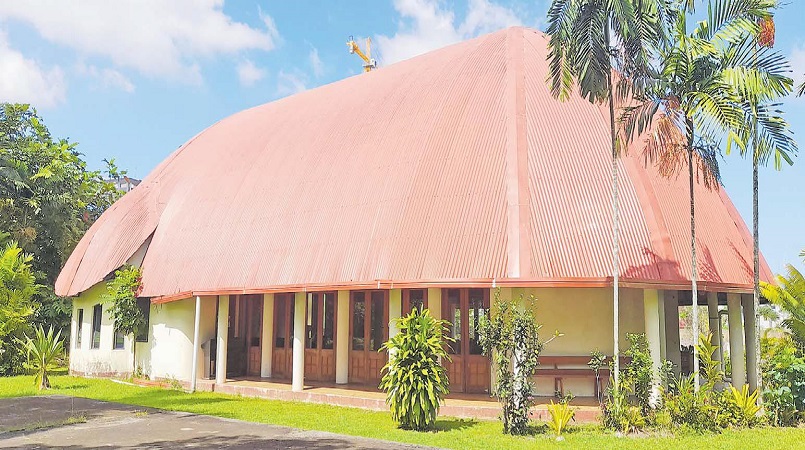
Samoans first migrated and settled in Levuka during the late 1890s to the 1900s and while some came to work on sugar cane plantations as part of the labour trade, others came through family connections.
But what became an integral part in the lives of these individuals was their link to spirituality and a push for an institution that fulfilled the needs for every Samoan in their faith.
During the late 1800s, the Samoan Congregational Church began with a handful of members in the Old Capital where majority were women and had spouses who worked as government officials.
Reverend Siu Vaifale said when the capital moved to Suva the church uprooted its foundation and moved to Naiqaqi for its mission outpost in Fiji.
On January 10, 1903 a three-acre plot was purchased for 250 pounds by seven Samoan pastors (Alama, Esene, Moli, Uili, Levi, Sa’aga and Otinielu) under the guidance of the London Missionary Society (LMS) in an area that was once used by the sugar mill industry before the church was built.
In 1904, the papers were registered under the names of John Marriot and John Hills, chairman and secretary of the LMS with the Fiji Registrar of Land and Titles and the first ‘faife’au’ (pastor) was Kuresa.
“It was kind of spearheaded by the European mission, but then we bought off the land from the LMS and we’ve been here ever since,” Rev Vaifale said.
The first building
What once stood ground on the property was a colonial wooden building that was typical to any other structure you would have seen during the early ’90s.
“There was a tender, a bid that went out to demolish the old church building and so the Methodist church in Nausori bought the demolished materials.”
On July 9, 1988 a newly-built church was opened by a delegation from Samoa led by the Rev Vavae Toma. Mr Vaifale shared how the Samoan inspired architectural building was a reflection of culture and authenticity, with its signature oval roof common among buildings in the land of Samoa.
“In Samoa you’ll see the churches are built typical to that of the white man, tall, A-shaped, pointed tops and here it was a unique opportunity to reflect away from colonialism.”
Samoan congregation
The church, for more than 100 years, has served to provide religious and pastoral support to the Samoan community, including many students from the regional university and working individuals.
“If you think 30 to 50 years ago, more than 100 families converged at the church on Sundays, now the numbers have dropped to almost eight families and a few students.
“We have also developed local seminaries back home so now we don’t send anymore scholarships students for training here so hence our numbers, but they used to be the large portion of the church.
“We are the dominant denomination in Samoa and we’ve been so since the inception of Christianity there although we are dropping numbers.
“What we are basically maintaining is our stance as the spiritual side of all Samoans here in Fiji because this is the only Samoan church here, regardless of what denomination.
“At the moment I’ve got the ambassador of Samoa as a member here and this is the church building that hosts all the national teams and government officials.
“We have been using the Samoan language since the beginning in the church so that has been maintained.”
Community involvement
Mr Vaifale said as he read through the records of those before him, he came across a certain minister that involved the members of the church in Fiji’s famous festival of the year.
“He took the church to the Hibiscus (festival) to participate a lot and he formed dance and cultural groups, but than that was during the ’70s and the ’80s and the government was advocating for participation from the community.”
He said another minister extended the service of the church to Nadi and Lautoka because there were some Samoans living there as well.
“I read that one particular pastor would go there for a week and come back the other week here which was quite challenging for him, but after him there was no other record of whether it continued.”
Background
The Congregational Christian Church in Samoa traces its roots back to the arrival of missionaries sent by the LMS in 1830 accompanied by missionary teachers from Tahiti, the Cook Islands and a Samoan couple from Tonga.
In a short span of years, the whole of Samoa converted to Christianity and the people offered to undertake missionary work.
It has been gathered that the missionaries arrived during a time of fierce warfare between local chiefs and as the people became weary of bloodshed and violence they readily accepted the gospel into their lives.
In 1839, the first twelve Samoan missionaries left for mission work in Melanesia. Since that time and up to 1975, Samoans have continued to spread across the Pacific, reaching the islands of Fiji.
“We’ve been here long and we comply with Fijian regulations, we appreciate being in Fiji and love the opportunity to be here as the spiritual arm of the Samoan people.
“We just recently opened up a Samoan High Commission, this is the government arm which has been here for at least two months but we have been here 100 years, so the spiritual and cultural arms have been here a long time and will remain much longer.”
